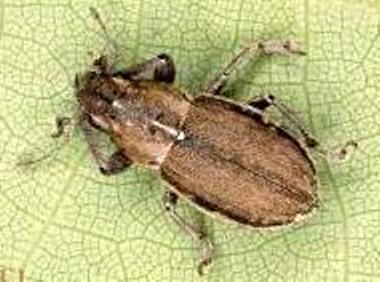|
Whitefringed Beetle
View more pictures: Bing Images Google Images Yahoo Images Common names: Whitefringed Beetle Scientific name: Graphognathus leucoloma Region: This Beetle is common to the southeastern United States. Life cycle: This beetle overwinters as a larva or an egg in the soil and produces one generation each year. Physical Description: This brown-gray beetle is about 1/2 inch long, has white hairs on its back, a short head/snout, and cannot fly. The eggs are coated with a very sticky substance and are laid in large groups and the base of plants. The yellowish white larva has no legs and is about 1/2 inch in length. Feeding characteristics: The whitefringed grub lives in the soil and feeds on the roots of beans and a variety of other vegetables and ornamentals. The larva eats the tender outer root tissues and may sever the main root, causing the plant to turn yellow and limp, eventually killing them. It has acquired a taste for about 400 plants. The adult is less dangerous to the garden and are particularly fond of legumes. Controls: Large-scale growers should not plant more than a quarter of there annual crop land in legumes, or plant the same land with legumes more than once in three to four years. On a smaller scale, the home gardener can control this pest more efficiently. Make sure you don't plant legumes together. Clean cultivation is the only effective organic control. Build the soil fertility so that the plant may become strong enough to fight off the beetles' attack. Return from Whitefringed Beetle to Insects U-Z Encyclopedia of Garden Insects |
